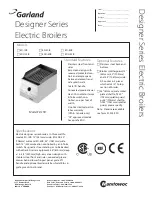
18
5.1 GAS SUPPLY INSTALLATION
Inspect the entire installation including the gas meter, test for
tightness and purge. Refer to BS 6891 (I.S. 813 in ROI) for
specific instruction.
5.2 THE HEATING SYSTEM
The appliance contains components that may become damaged
or rendered inoperable by oils and/or debris that are residual
from the installation of the system, consequently it is essential
that the system be flushed in accordance with the following
instructions.
5.3 INITIAL FILLING OF THE SYSTEM
Ensure both flow and return service valves are open, remove
appliance casing as described in 4.7.1, identify the automatic air
release valves (AAV) and loosen the dust cap/s by turning the
cap anti-clockwise one full turn. Ensure all manual air release
valves located on the heating system are closed. Connect the
filling loop, slowly proceed to fill the system by firstly opening
the inlet valve connected to the flow pipe, and then turning the
lever on the fill valve, to the open position. As water enters the
system the pressure gauge will begin to rise. Once the gauge
has reached 1 BAR close both valves and begin venting all
manual air release valves, starting at the lowest first. It may be
necessary to go back and top-up the pressure until the entire
system has been filled. Inspect the system for water tightness,
rectifying any leaks.
5.4 INITIAL FLUSHING OF THE SYSTEM
The whole of the heating system must be flushed both cold
and hot as detailed in 5.8. Open all radiator or heating valves
and the appliance flow & return service valve. Drain the boiler
and system from the lowest points. Open the drain valve full
bore to remove any installation debris from the boiler prior to
lighting. Refill the boiler and heating system as described in 5.3.
SECTION 5 - COMMISSIONING
4.7.1 CASING REMOVAL (fig. 25)
To gain internal access to the appliance you must first remove
the casing, proceed as outlined below:
•
locate and unscrew the 2-screws (
A
) that secure the outer
casing to the appliance
•
lift the casing upward to disengage it from the top locating
hooks and then remove
•
store the casing and screws safely until required. Re-fit in
the reverse order
•
locate and remove the securing screw at the bottom of the
control panel and lower the panel’
Fig. 25
A
4.7.2 APPLIANCE TERMINAL BLOCK
The appliance terminal block is located on the rear of the con-
trol fascia. Remove the casing as described in 4.7.1. Gently
pull the control panel forwards and down. Locate the terminal
block cover (fig. 26).
NOTE
The appliance is supplied with a ‘plug & play’ controls lead
that enables quick and easy connection to various Vokèra
controls; refer to Section-8 for more detailed information on
how to connect external controls.
Fig. 26
4.7.3 CONNECTING THE MAINS (230V) INPUT
Unhook and remove the terminal block cover (230V). Pass the
cable through the cable anchorage point. Connect the supply
cable wires (LIVE, NEUTRAL, & EARTH) to their corresponding
terminals (L, N, & E) on the appliance – high voltage – terminal
block. When connecting the EARTH wire, ensure that it’s left
slightly longer that the others, this will prevent strain on the
EARTH wire should the cable become taut.
Do not remove the link wire unless additional external controls
are to be fitted (see section 8). The securing screw on the cable
anchorage should now be tightened. This must be done before
the terminal block cover is re-fitted in its position.
NOTE
It is the installer’s responsibility to ensure that the appliance is
properly Earthed. Vokèra Ltd. cannot be held responsible for
any damages or injuries caused as a result of incorrect Earth
wiring.
5.5 PRE-OPERATION CHECKS
Before attempting the initial lighting of the appliance, the fol-
lowing checks must be carried out:
•
ensure all gas service valves from the meter to the appliance
are open and the supply pipe has been properly purged;
•
ensure the proper electrical checks have been carried out,
(see 7.8) particularly continuity, polarity and resistance to
earth;
•
ensure the 3 AMP fuse – supplied with the appliance – has
been fitted;
•
ensure the system has been filled, vented and the pressure
set to 1 BAR;
•
ensure the flue system has been fitted properly and in ac-
cordance with the instructions;
•
ensure all appliance service valves are open.
5.6 INITIAL LIGHTING
Ensure the electrical supply to the appliance is switched on.
Ensure any external controls are switched to an ‘ON’ position
and are calling for heat. Move the selector switch to the ON
position, the appliance will now operate as described in 1.2.
Should the appliance fail to ignite, refer to 5.6 and/or section 7
(mode of operation, parameter setting & faultfinding).
5.7 CHECKING GAS PRESSURE AND COMBUS-
TION ANALYSIS
The appliance is factory set so should require no additional
adjustment once installed. However to satisfy the requirements
of GSIUR 26/9 (I.S. 813 ROI), it will be necessary to gas rate
the appliance using the gas meter that serves the appliance
and carry out a combustion analysis check in accordance with
BS 7967 (UK) to ensure that correct combustion is occurring,
see flow chart on page 36.
















































